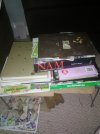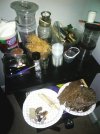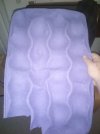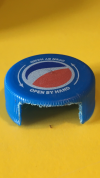Greetings to all who come across this thread! I would like to share some tips and tricks to having a beautiful T enclosure (can work for most inverts and even reptiles!)
1. Money don't grow on trees, but WOOD/BARK and other awesome decor DO! A lot of vendors sell you decorative pieces they got themselves or through 3rd party contractors that sell them what they need at bulk prices. Take for instance some bark and driftwood at my local shop in town. I would be looking at $25-$50+ for a few pieces. The pieces werent exactly what I needed and because of how they are treated and cut so it is hard to try and fix that to fit your specific needs. I am a HUGE advocate of DIY for many aspects of animal keeping. To stay on topic I will stick with the decorative aspects of your enclosures. I always leave home with my backpack in case I encounter awesome pieces. A tree had died and the bark was beautifully coming apart in huge pieces. Long flat pieces and curved ones that I knew would look so awesome in my enclosures. * I recommend cleaning and baking pieces you find in the wild just as a precautionary measure. *
When I bring the pieces home I soak and scrub them in a large rubber bin using a regular bristle brush to remove and clean the piece. Now the more you soak the more pliable the pieces of bark and wood become. I take this time after cleaning and removing excess layers to begin shaping my pieces. I take junk mail, old newspaper, brown bags and those glossy pieces work great too when you lay them on a flat surface. Example: Lay paper down on flat surface and put X amount of bark/wood of similar thickness down on top. Then add a final layer of paper on top of those pieces. Lastly you want to find heavy flat objects to be set on top of the pieces to help keep flattened and dry in that form. I use books. There are tons of house hold items you can use for this part.
Some pieces that look perfect upon harvest you can throw in the oven at 450 for 10-15mins and then lay out to cool. That will kill off anything living on that bark without harming the actual piece.
TBH I have skipped baking and usually do one or the other since they both are extremely effective in making those pieces safe.
2. Rocks rock! Another great find right in our own backyards. Beautiful rocks of all sizes are found all around us if you know where to look. You can choose to go into the wilderness to seek them, or walk your neighborhood along trees and buildings for gorgeous specimens. There is a crab shack across the street and their sign has hundreds if not thousands of nice sized beautiful display rocks piled up. I take only a couple and wash them off, keeping them for immediate but also later use. Moss that grows on trees and rocks I collect as well because it has many uses. It not only looks cool but it holds moisture in such a way it is perfect for managing humidity without having to spray and that works out great for me so I don't need to get my beautiful bark soaked.
3. Isopods are WORTH IT!
I caught mine wild and let me tell you they help keep mold, fungi, mites and much more out of your vivarium/enclosures etc. They are powerful cleaners who will not harm your T and IMO are super adorable. When I first collected my Pillbugs I put them in their own enclosure to quarantine them and check for any warning signs and not surprising at all they were thriving and healthy. I did have control groups just like I did with the moss and the most I took away from that experience was positive. If you want to keep your enclosures cleaner without you having to intervene and enjoy longer periods between changing substrate the isopods are a must. They work best in enclosures with bigger T's and not slings.
4. Live plants are beneficial not to mention you can get them free or for very cheap depending on how you aquire them. You might have several house plants you can use in your enclosure. That is exactly how my first plants were used. I had clippings that rooted and were in water only (They could have been planted into the substrate but I decided to keep them in the water dish.) It worked wonderfully not to mention the plant grew like a vine so it looked amazing against the bark covered back of the enclosure fit with a separate curved piece of bark that fit against the bark backing blending in like a branch or thick vine that was hollowed and used as my AA's hide. The plant creeped along the ground making its way up that cylindrical hide before branching off in many awesome directions. You can go to local plant shops and ask them for clippings and even ask if there's any plants that may be damaged that you can have for free or discounted and just water them, crop the unhealthy parts or find the healthiest pieces and transplant them for a few days. A lot of flower shops especially are prone to haggling and freebies. Just need to make sure whatever you get won't grow too big to handle lmao.
5. Enclosures DIY, Freebies on Letgo, CL and pet supply shop for free or next to nothing. THRIFT STORES for a lot of decorations, stands and more. Garage sales, throw aways in your area and PET STORE garbage picking you can find a lot of new, unused, unsold and slightly damaged goods that are USEABLE and can be fixed if need be.
6. Deli cups condiment cups, gallon sizes and whatnot for T's who are not ready for their permanent enclosure. Grocery Stores have them in stacks and you can grab several of them at a time and have a personal stock. I have never heard of someone being questioned about it. Just maybe don't clear the shelves lol. It isn't an issue. Another thing with grocery stores is the fruits and veggies come on cardboard similar to egg crates and you can ask the workers if you can take some (they are garbage at this point) and you end up with plenty of cardboard for your feeders. Another thing you can do is ask them about produce they are getting rid of. Usually you see boxes of produce by workers while sorting or underneath the produce displays and just grab a bag and fill it up. Makes healthy food for feeders and herbivores alike. Also using recycled goods like plastic bottles, juice containers, pill bottles and cardboard can be repurposed. Turning them into a number of useful things. I use bottle caps as hides and water dishes. For the tiniest slings I use caps to markers, pens and my favorite are the backs of insulin syringes. They have 2 caps one to cover the needle and a second one at the other end of the syringe. My slings love those end caps! I also grab those paper cups used for ketchup at fast food places because I can grab a ton without worry and they come in handy. I am using that as a hide for Namira, my cute little G. Pulchripes.
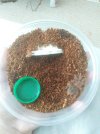

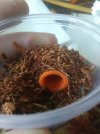

I hope you liked these tips and I will be posting footage and pictures of how I aquire said materials as well as more in depth answers to anyone who is curious.
Reply here or PM me.
I will be updating this within the next few days!
-- Pinky
1. Money don't grow on trees, but WOOD/BARK and other awesome decor DO! A lot of vendors sell you decorative pieces they got themselves or through 3rd party contractors that sell them what they need at bulk prices. Take for instance some bark and driftwood at my local shop in town. I would be looking at $25-$50+ for a few pieces. The pieces werent exactly what I needed and because of how they are treated and cut so it is hard to try and fix that to fit your specific needs. I am a HUGE advocate of DIY for many aspects of animal keeping. To stay on topic I will stick with the decorative aspects of your enclosures. I always leave home with my backpack in case I encounter awesome pieces. A tree had died and the bark was beautifully coming apart in huge pieces. Long flat pieces and curved ones that I knew would look so awesome in my enclosures. * I recommend cleaning and baking pieces you find in the wild just as a precautionary measure. *
When I bring the pieces home I soak and scrub them in a large rubber bin using a regular bristle brush to remove and clean the piece. Now the more you soak the more pliable the pieces of bark and wood become. I take this time after cleaning and removing excess layers to begin shaping my pieces. I take junk mail, old newspaper, brown bags and those glossy pieces work great too when you lay them on a flat surface. Example: Lay paper down on flat surface and put X amount of bark/wood of similar thickness down on top. Then add a final layer of paper on top of those pieces. Lastly you want to find heavy flat objects to be set on top of the pieces to help keep flattened and dry in that form. I use books. There are tons of house hold items you can use for this part.
Some pieces that look perfect upon harvest you can throw in the oven at 450 for 10-15mins and then lay out to cool. That will kill off anything living on that bark without harming the actual piece.
TBH I have skipped baking and usually do one or the other since they both are extremely effective in making those pieces safe.
2. Rocks rock! Another great find right in our own backyards. Beautiful rocks of all sizes are found all around us if you know where to look. You can choose to go into the wilderness to seek them, or walk your neighborhood along trees and buildings for gorgeous specimens. There is a crab shack across the street and their sign has hundreds if not thousands of nice sized beautiful display rocks piled up. I take only a couple and wash them off, keeping them for immediate but also later use. Moss that grows on trees and rocks I collect as well because it has many uses. It not only looks cool but it holds moisture in such a way it is perfect for managing humidity without having to spray and that works out great for me so I don't need to get my beautiful bark soaked.
3. Isopods are WORTH IT!
I caught mine wild and let me tell you they help keep mold, fungi, mites and much more out of your vivarium/enclosures etc. They are powerful cleaners who will not harm your T and IMO are super adorable. When I first collected my Pillbugs I put them in their own enclosure to quarantine them and check for any warning signs and not surprising at all they were thriving and healthy. I did have control groups just like I did with the moss and the most I took away from that experience was positive. If you want to keep your enclosures cleaner without you having to intervene and enjoy longer periods between changing substrate the isopods are a must. They work best in enclosures with bigger T's and not slings.
4. Live plants are beneficial not to mention you can get them free or for very cheap depending on how you aquire them. You might have several house plants you can use in your enclosure. That is exactly how my first plants were used. I had clippings that rooted and were in water only (They could have been planted into the substrate but I decided to keep them in the water dish.) It worked wonderfully not to mention the plant grew like a vine so it looked amazing against the bark covered back of the enclosure fit with a separate curved piece of bark that fit against the bark backing blending in like a branch or thick vine that was hollowed and used as my AA's hide. The plant creeped along the ground making its way up that cylindrical hide before branching off in many awesome directions. You can go to local plant shops and ask them for clippings and even ask if there's any plants that may be damaged that you can have for free or discounted and just water them, crop the unhealthy parts or find the healthiest pieces and transplant them for a few days. A lot of flower shops especially are prone to haggling and freebies. Just need to make sure whatever you get won't grow too big to handle lmao.
5. Enclosures DIY, Freebies on Letgo, CL and pet supply shop for free or next to nothing. THRIFT STORES for a lot of decorations, stands and more. Garage sales, throw aways in your area and PET STORE garbage picking you can find a lot of new, unused, unsold and slightly damaged goods that are USEABLE and can be fixed if need be.
6. Deli cups condiment cups, gallon sizes and whatnot for T's who are not ready for their permanent enclosure. Grocery Stores have them in stacks and you can grab several of them at a time and have a personal stock. I have never heard of someone being questioned about it. Just maybe don't clear the shelves lol. It isn't an issue. Another thing with grocery stores is the fruits and veggies come on cardboard similar to egg crates and you can ask the workers if you can take some (they are garbage at this point) and you end up with plenty of cardboard for your feeders. Another thing you can do is ask them about produce they are getting rid of. Usually you see boxes of produce by workers while sorting or underneath the produce displays and just grab a bag and fill it up. Makes healthy food for feeders and herbivores alike. Also using recycled goods like plastic bottles, juice containers, pill bottles and cardboard can be repurposed. Turning them into a number of useful things. I use bottle caps as hides and water dishes. For the tiniest slings I use caps to markers, pens and my favorite are the backs of insulin syringes. They have 2 caps one to cover the needle and a second one at the other end of the syringe. My slings love those end caps! I also grab those paper cups used for ketchup at fast food places because I can grab a ton without worry and they come in handy. I am using that as a hide for Namira, my cute little G. Pulchripes.




I hope you liked these tips and I will be posting footage and pictures of how I aquire said materials as well as more in depth answers to anyone who is curious.
Reply here or PM me.
I will be updating this within the next few days!
-- Pinky
Last edited:

